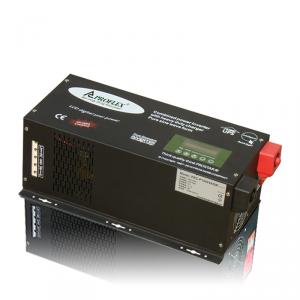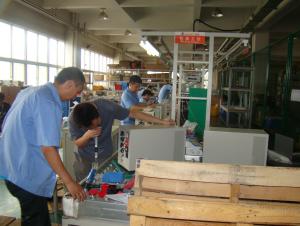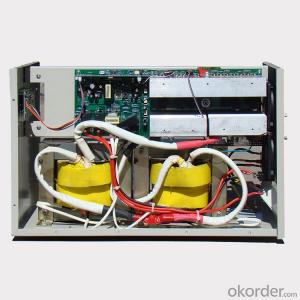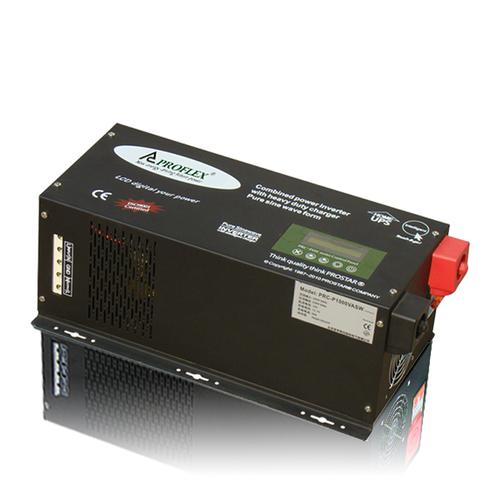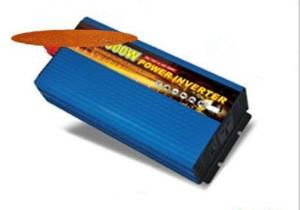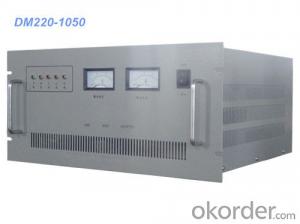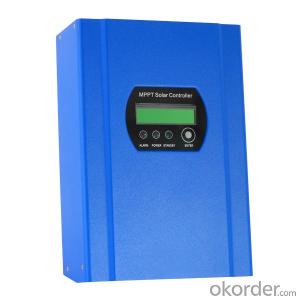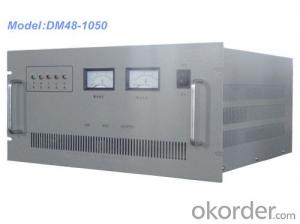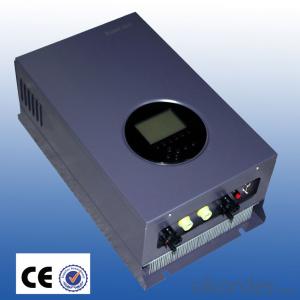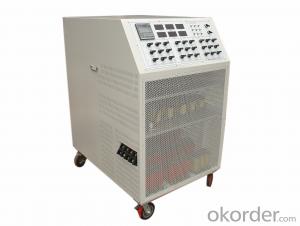Baywa Re Solar Energy Systems - Pure Sine Wave Power Inverter with Battery Charger 5KW
- Loading Port:
- Tianjin
- Payment Terms:
- TT OR LC
- Min Order Qty:
- 10 pc
- Supply Capability:
- 10000 pc/month
OKorder Service Pledge
OKorder Financial Service
You Might Also Like
Specification
Specifications
DC to AC power inverter
Pure sine wave
with battery charger
standard LCD display
Battery charge current can be manually set
DC TO AC INVERTER
PURE SINE WAVE WITH BATTERY CHARGER
Advantages
> Ultra-fast transfer timeFrom AC to DC less than 5ms,
> From DC to AC 0ms (Routers, Switches PC, Servers and ATM machine will never re-start at Mains failure)
> Faster battery recharge time (Big charge current 30A~50A)
> Automatic tracking mains or generator input (Tracking input voltage, phase & frequency)
> AC / DC conversion waveform (Seamless connection without any spike)
> Battery equalization system (for longer battery life)
> Protection against short-circuit, low voltage, overload, over temperature and over-charge
> Low maintenance cost, LED & LCD Dual display
Application range
Computer, Telecom, Deep Freezers, Air Conditioners, Petrol pump machines, Small Scale Industries Malls, Hotels,
Restaurants, Banks, ATM Machines, Clinics, All kinds of Kitchen appliances & Home appliances, Weighing bridges,
Elevators etc.
Technical Specification
| PRC-PSW SERIES | 500VA | 1000VA | 1500VA | 2000VA | 3000VA | 4000VA | 5000VA | 6250VA |
| POWER CAPACITY | 400W | 800W | 1200W | 1600W | 2400W | 3200W | 4000W | 5000W |
| BATTERY DC VOLTAGE | 12V/24V/48V | 24V/48V | ||||||
| INPUT AC RANGE | 140~280V / 45~55Hz | 165~275V / 45~55Hz | ||||||
| INVERTER OUTPUT | 220V ± 10% / 50Hz ± 1% | Without AVR function | ||||||
| TRANSFER (AC LOSS) | 5ms after AC loss, automatic recovery after utility power back | |||||||
| WAVE DISTORTION | THD < 3% | |||||||
| OVER LOAD CAPACITY | 100% ~ 125% Keep Beeping; > 125% working 30s; >150% 1s shut down | |||||||
| OUTPUT SOCKET | terminal connectors | |||||||
| INDICATOR STATUS | Utility input with "POWER" & "BYPASS" light on | |||||||
| Utility power loss with "INVERTER" light on | ||||||||
| Connected with load "AC OUTPUT" light on | ||||||||
| Warning for battery low & over load with " ! " flashing | ||||||||
| Battery low protection, over load protection, short circuit protection with " ! " light on | ||||||||
| BATTERY CAPACITY | From left to right 4 indicator means 100%, 75%, 50%, 25% (" ! "Flashing) | |||||||
| CHARGE STATUS | Indicator flash change from 50% →75% → 100% every 1second means "CONSTANT CURRENT" | |||||||
| Indicator flash change from 50% →75% → 100% every 2second means "CONSTANT VOLTAGE" | ||||||||
| Indicator 50%/75%/100% 3lights on means "FLOAT CHARGE" & battery full | ||||||||
| CHARGE CURRENT | Maximum 12V 30A / 24V 20A / 48V 10A | Maximum 24V 50A or 48V 30A | ||||||
| 10A → 20A → 30A Adjustable | 10A → 30A → 50A Adjustable | |||||||
| RECHARGE TIME | 8~10hours | |||||||
| POWER EFFICIENCY | 88% at full load | 85% at full load | ||||||
| NOISE CONDITION | < 45dB | |||||||
| TEMPERATURE | —10°C ~ 40°C (Operation environment); —20°C ~ 50°C (Stock environment) | |||||||
| HUMIDITY | 0~95% no condensation | |||||||
| SIZE OF INVERTER | 550 x 250 x 200mm | 650 x 250 x 200 mm | 68x31x28cm | |||||
| SIZE OF PACKAGE | 58x28x23cm / 1unit | 68x28x23cm / 1unit | 71x34x31cm | |||||
| TYPE OF PACKAGE | Honeycomb carton | |||||||
| WEIGHT OF INVERTER | 11kg | 13kg | 14kg | 25kg | 27kg | 38kg | 39kg | 47kg |
| WEIGHT AFTER PACKAGING | 13kg | 15kg | 16kg | 27kg | 29kg | 40kg | 41kg | 49kg |
Advantages
CPU control, Low frequency
Pure sine wave output
5ms transfer time for AC to DC
Input voltage range 80V~140V/160V~265V
Input frequency range 45~55Hz/55~65Hz
Easy to install, easy to use
Intelligent automatic charging
Compatible with generators
Using line interactive circuit technology
Automatically AC bypass
Software & SNMP card optional with adding cost
Electronic Protections
Overload, short circuit protection
Over temperature protection
Over voltage, low voltage protection
Low battery protection

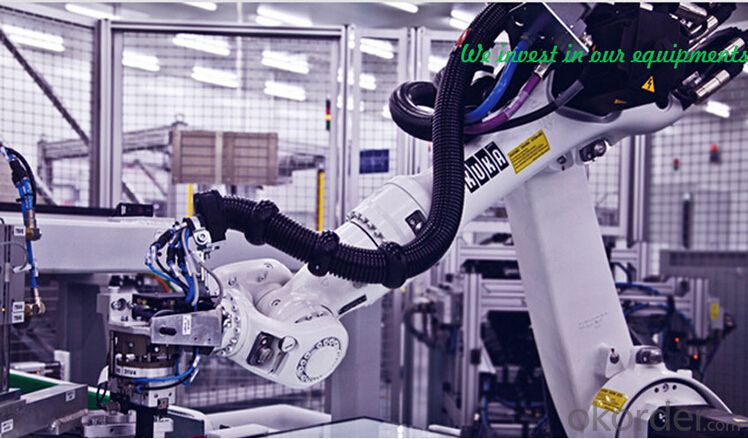
- Q: Can solar energy systems be used in areas with high wind conditions?
- Yes, solar energy systems can be used in areas with high wind conditions. While wind turbines are typically used to harness wind energy, solar panels can still be installed and function effectively in such areas. The performance of solar panels may be slightly impacted by the presence of wind, but with proper design and installation, they can still generate significant amounts of clean energy.
- Q: What are the advantages of using solar energy systems?
- There are several advantages of using solar energy systems. Firstly, solar energy is a renewable and abundant source of energy. It is derived directly from the sun, which means it will never run out. Secondly, solar energy systems are environmentally friendly as they produce zero greenhouse gas emissions during operation, reducing our carbon footprint and combating climate change. Additionally, solar energy systems require minimal maintenance, resulting in lower operating costs compared to traditional energy sources. Moreover, installing solar panels on rooftops can help households and businesses save money on their electricity bills by generating their own clean and free energy. Finally, solar energy systems can provide energy independence, reducing reliance on fossil fuels and the risks associated with fluctuating energy prices.
- Q: Can solar energy be used for hot water?
- Yes, solar energy can be used to heat water through the use of solar thermal systems or solar water heaters. These systems collect the sun's energy and transfer it to the water, providing a sustainable and cost-effective solution for hot water production.
- Q: Can solar energy be used for large-scale power generation?
- Yes, solar energy can be used for large-scale power generation. With advancements in technology and decreasing costs of solar panels, solar power plants are being built around the world to generate electricity on a massive scale. These power plants can be grid-connected and provide clean and renewable energy to meet the increasing demand for electricity.
- Q: Can a solar energy system be installed on a sports field or stadium?
- Yes, a solar energy system can be installed on a sports field or stadium. In fact, many sports fields and stadiums around the world have already adopted solar energy systems to meet their energy needs. These systems typically consist of solar panels that are installed on the roofs or surrounding areas of the facility. The large surface area of sports fields and stadiums often makes them ideal locations for solar panel installations. The benefits of installing a solar energy system on a sports field or stadium are numerous. Firstly, it allows the facility to generate clean and renewable energy, reducing its reliance on traditional fossil fuels and lowering its carbon footprint. This aligns with the growing global concern for environmental sustainability. Additionally, solar energy systems can significantly reduce energy costs for sports facilities in the long run. The electricity generated from solar panels can be used to power the stadium lights, scoreboards, sound systems, and other equipment. Any excess energy can be fed back into the grid, potentially earning the facility revenue through net metering or feed-in tariffs. Furthermore, installing a solar energy system on a sports field or stadium can serve as a powerful symbol of environmental consciousness and sustainability. It can inspire and educate fans, athletes, and the larger community about the importance of renewable energy and the potential for solar power in meeting our energy needs. In summary, a solar energy system can indeed be installed on a sports field or stadium, providing numerous benefits such as clean and renewable energy generation, reduced energy costs, and promoting environmental sustainability.
- Q: Can solar energy systems be used in areas with limited roof access for maintenance?
- Yes, solar energy systems can be used in areas with limited roof access for maintenance. While it is more common to install solar panels on rooftops for optimal sun exposure, there are alternative options available. Ground-mounted solar panels can be installed in areas where roof access is limited, allowing for easier maintenance and cleaning. Additionally, solar panel systems can also be integrated into other structures such as carports or pergolas, providing an alternative to traditional rooftop installations. These alternatives ensure that solar energy systems can be utilized effectively in areas with limited roof access for maintenance.
- Q: Can solar energy systems be used in powering government buildings or offices?
- Yes, solar energy systems can be used to power government buildings or offices. In fact, many government buildings around the world have already adopted solar energy systems as a means of reducing their carbon footprint and dependence on traditional energy sources. Solar panels can be installed on rooftops or in open spaces adjacent to government buildings, harnessing sunlight to generate electricity that can be used to power various activities within the buildings. This sustainable approach not only helps in reducing greenhouse gas emissions but also saves money on energy bills in the long run.
- Q: What are the different financing options for solar energy systems?
- There are several financing options available for solar energy systems, including cash purchases, solar loans, solar leases, power purchase agreements (PPAs), and property assessed clean energy (PACE) financing. Cash purchases involve paying the full cost of the system upfront. Solar loans allow homeowners to borrow money to finance the system and pay it back over time with interest. Solar leases involve leasing the system from a third-party provider and paying a fixed monthly fee. PPAs allow homeowners to purchase the electricity generated by the system at a predetermined rate. PACE financing allows homeowners to finance the system through an additional assessment on their property taxes.
- Q: Can solar energy systems be used for powering hospitals?
- Yes, solar energy systems can indeed be used for powering hospitals. Solar panels can be installed on the rooftops or nearby areas of hospitals to generate clean and renewable electricity. This energy can then be used to power various hospital operations, including lighting, medical equipment, refrigeration, heating, and cooling systems. Solar energy systems can help hospitals reduce their reliance on fossil fuels, lower their energy costs, and contribute to a more sustainable and resilient healthcare infrastructure.
- Q: What is the role of microinverters in solar energy systems?
- Microinverters play a crucial role in solar energy systems as they convert the direct current (DC) generated by each individual solar panel into alternating current (AC) that can be used to power appliances and be connected to the electrical grid. By allowing each panel to operate independently, microinverters optimize the overall performance of the system, increase energy production, and provide greater flexibility in system design and monitoring.
Send your message to us
Baywa Re Solar Energy Systems - Pure Sine Wave Power Inverter with Battery Charger 5KW
- Loading Port:
- Tianjin
- Payment Terms:
- TT OR LC
- Min Order Qty:
- 10 pc
- Supply Capability:
- 10000 pc/month
OKorder Service Pledge
OKorder Financial Service
Similar products
Hot products
Hot Searches
Related keywords
